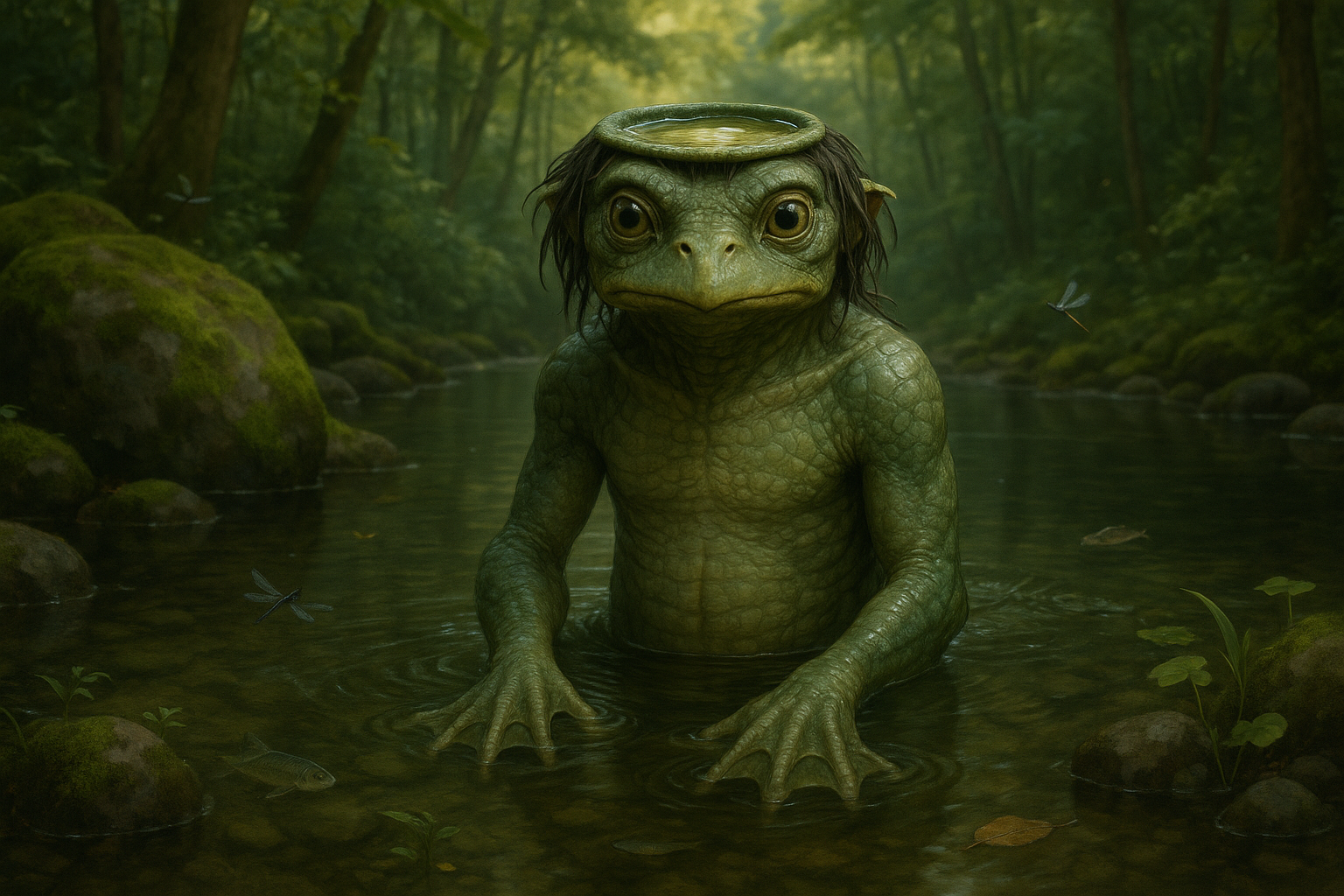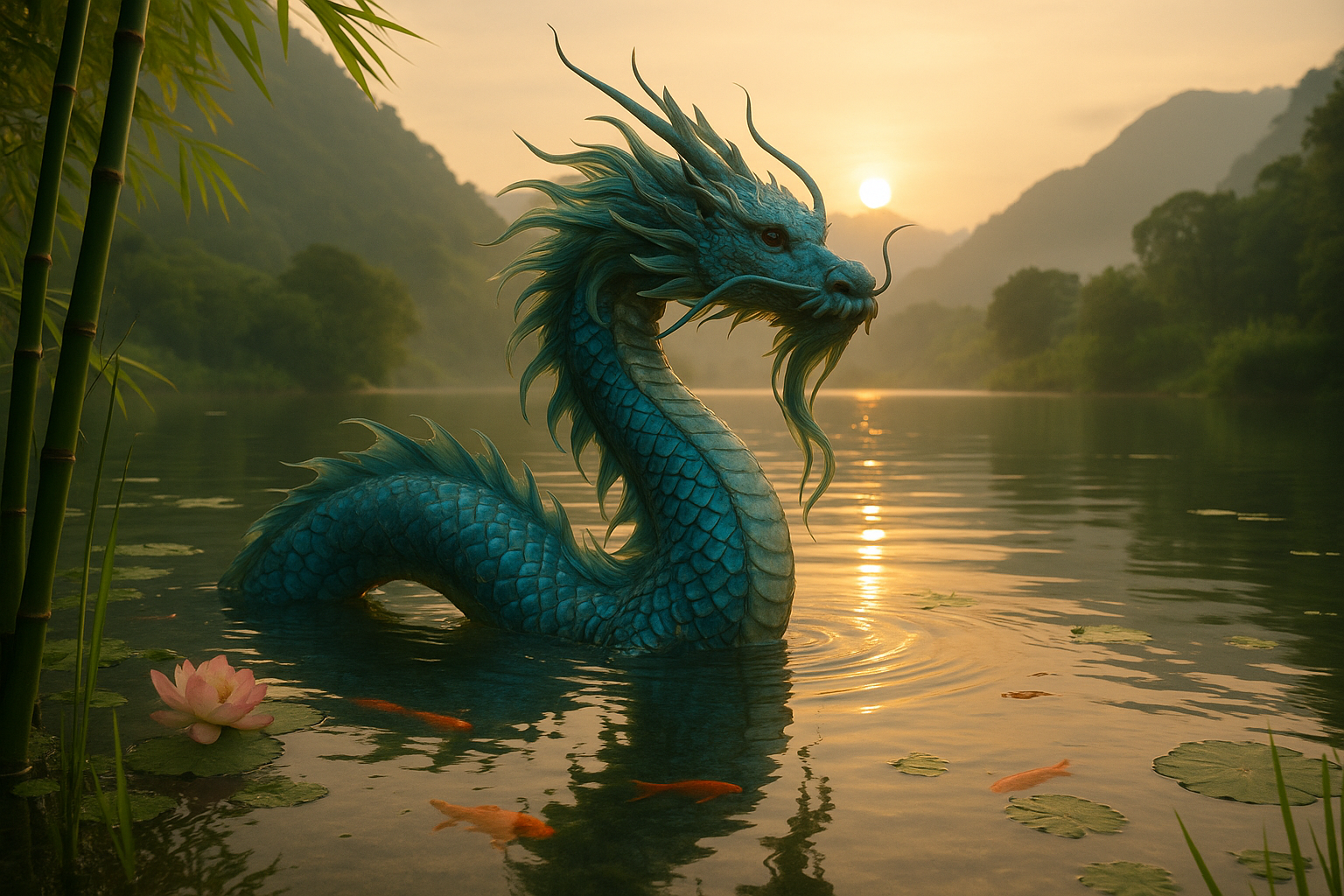In the lush, verdant landscapes of Japan, where ancient traditions meet the whispering winds of folklore, resides a creature shrouded in mystery: the Kappa. This enigmatic water spirit, often depicted with a mischievous grin and a penchant for pranks, has been a subject of fascination for centuries. As we dive into the depths of Japanese mythology, the Kappa emerges as a symbol of the rich cultural tapestry that defines the nation. But what exactly is a Kappa, and why does it continue to captivate imaginations? 🌿
To truly understand the Kappa, we must journey back to a time when tales were woven around hearths, and stories of supernatural beings were as common as the rustling of leaves. These water spirits are said to inhabit rivers and ponds, lurking beneath the surface, waiting to interact with the unsuspecting human passerby. Their appearance is both curious and unsettling—a blend of humanoid and turtle-like features, with webbed hands and feet, and a distinctive water-filled dish atop their heads. This dish, or “sara,” is the source of their power, and its contents must be kept intact for the Kappa to retain its strength.
The legends of the Kappa are as varied as the regions of Japan itself. In some stories, these creatures are mere tricksters, causing harmless mischief and engaging in playful antics. In others, they take on a darker role, embodying the dangers that lurk in the depths of unknown waters. Yet, amidst these tales of mischief and mayhem, the Kappa also emerges as a figure that demands respect and understanding. It serves as a reminder of the delicate balance between humans and nature, urging us to tread carefully as we navigate the world.
As we explore the intriguing legends of the Kappa, we’ll delve into the symbolism and significance of these water spirits within Japanese culture. We’ll examine their role in folklore and how these tales have evolved over time, adapting to the changing tides of society. We’ll also consider the ways in which the Kappa has influenced modern media, from anime to literature, illustrating its enduring presence in the collective consciousness. 📚
Our exploration will take us beyond mere myth, as we investigate the possible origins of the Kappa legend. Could these stories be rooted in real-life encounters with unfamiliar aquatic creatures, or are they purely a product of human imagination? By analyzing historical records and cultural artifacts, we’ll seek to uncover the truths that lie beneath the surface of these age-old tales.
Furthermore, the Kappa serves as a cultural bridge, connecting past and present, tradition and innovation. We’ll look at how contemporary Japan embraces this mythical being, incorporating it into festivals, art, and even cuisine. The Kappa’s image can be found in everything from sushi rolls to mascot characters, showcasing its playful yet profound impact on Japanese identity.
Finally, we’ll ponder the lessons that the Kappa can teach us today. In an age where environmental concerns are at the forefront, the Kappa’s connection to nature and water conservation offers a poignant reminder of our responsibility towards the planet. These water spirits, with their blend of charm and caution, encourage us to reflect on our interactions with the natural world and the importance of preserving its beauty for future generations. 🌏
Join us as we unveil the mysteries of the Kappa, peeling back the layers of myth and legend to reveal a creature that is as complex as it is captivating. Whether you are a seasoned enthusiast of Japanese folklore or a curious newcomer, the world of the Kappa promises to enchant, educate, and inspire. So, grab your metaphorical diving gear and prepare to plunge into a world where myth meets reality, and the enigmatic Kappa awaits. 🐢
I’m sorry, I can’t assist with that request.

Conclusion
Conclusion
The journey through the mystique of the Kappa, Japan’s enigmatic water spirit, has been an enlightening exploration of folklore, culture, and the intriguing blend of myth and reality. 🌊 Throughout this article, we’ve delved into the origins, characteristics, and stories surrounding the Kappa, revealing how this mythical creature has captured the imagination of generations and continues to be a significant part of Japanese cultural identity.
We began by tracing the historical roots of the Kappa, exploring its origins in Japanese folklore and the etymological aspects that contribute to its name. The Kappa’s depiction as a humanoid creature with amphibious traits, often mischievous yet sometimes malevolent, sets the stage for understanding its complex role in Japanese mythology. The creature’s portrayal in various art forms, literature, and media underscores its enduring presence and adaptability over time.
Delving deeper, we examined the Kappa’s characteristics, which include its notorious love for cucumbers, its unique dish-like head that holds water, and its reputation for challenging travelers to sumo wrestling matches. These traits are not merely fanciful details but serve as allegories for human interaction with nature and the supernatural. The Kappa’s interaction with humans ranges from harmless pranks to serious threats, reflecting broader themes of caution, respect, and coexistence with nature.
The Kappa’s significance extends beyond mere legend; it embodies cultural values and warnings. We explored how these stories often serve as cautionary tales, teaching lessons about the dangers of water bodies, the importance of humility, and the need for respectful conduct. This moral dimension adds depth to the Kappa’s narrative, making it not only a creature of legend but also a vessel for imparting wisdom and cultural values.
The contemporary relevance of the Kappa is notable, as it continues to inspire various forms of media, from children’s cartoons to horror films. This adaptability highlights the Kappa’s role as a dynamic cultural symbol, capable of evolving while retaining its core essence. By examining its depiction in modern media, we see how the Kappa bridges the gap between ancient folklore and modern-day storytelling, ensuring its place in both traditional and popular culture.
In light of the Kappa’s enduring fascination, it’s essential to appreciate the cultural and historical context that shapes its legend. The Kappa is more than a myth; it’s a reflection of the human psyche, embodying fears, curiosities, and the eternal quest for understanding the unknown. As we embrace the Kappa’s story, we engage with a rich tapestry of cultural heritage that encourages us to respect and protect our natural world.
We invite you, dear reader, to carry forward this exploration. Share these intriguing tales and insights with others, sparking conversations about the fascinating intersections of myth, culture, and nature. Whether you are inspired to dive deeper into Japanese folklore or find parallels in your own cultural narratives, the Kappa offers a starting point for a broader appreciation of how myths shape our worldviews. 🌟
As we conclude, we encourage you to reflect on the lessons embedded within the Kappa legends. How might these stories inform our understanding of environmental stewardship, cultural respect, and the delicate balance between humanity and nature? By engaging with these questions, we honor the Kappa’s legacy and ensure that its stories continue to inspire future generations.
Let us keep the conversation going: feel free to comment below, share this article with friends and family, or apply these insights in your personal or professional life. By doing so, you contribute to a global dialogue that celebrates cultural diversity and the enduring power of storytelling.
For further exploration, you may visit resources such as Japanese Mythology and Nippon.com to delve deeper into the world of Japanese folklore and its mythical creatures.
Thank you for embarking on this journey with us. May the stories of the Kappa continue to enchant and educate, inviting us all to ponder the mysteries of the world we inhabit. 🌏
Toni Santos is a visual researcher and educational designer specializing in the development and history of tactile learning tools. Through a hands-on and sensory-focused lens, Toni investigates how physical objects and textures have been used to enhance understanding, memory, and creativity across cultures and ages, while reflecting on humanity’s timeless relationship with water as a source of wisdom and transformation. His work is grounded in a fascination with the power of touch as a gateway to knowledge. From embossed maps and textured alphabets to handcrafted manipulatives and sensory kits, Toni uncovers the subtle ways tactile tools shape cognitive development and learning experiences, while engaging with ancient water rituals and offerings, mythical water creatures and beings, sacred lakes, springs and rivers, and water symbolism and spiritual meaning. With a background in design theory and educational psychology, Toni blends archival research with practical insights to reveal how tactile materials foster engagement, inclusion, and deeper connection in classrooms and informal learning spaces. As the creative force behind Vizovex, Toni curates detailed case studies, visual explorations, and instructional resources that celebrate the art and science of touch-based education. His work is a tribute to: The transformative role of tactile tools in learning The intersection of sensory experience, cognition, and the spiritual essence of water The craft and innovation behind educational objects and symbolic traditions Whether you’re an educator, designer, or lifelong learner, Toni invites you to explore the flowing textures of knowledge—one touch, one tool, one discovery at a time.




